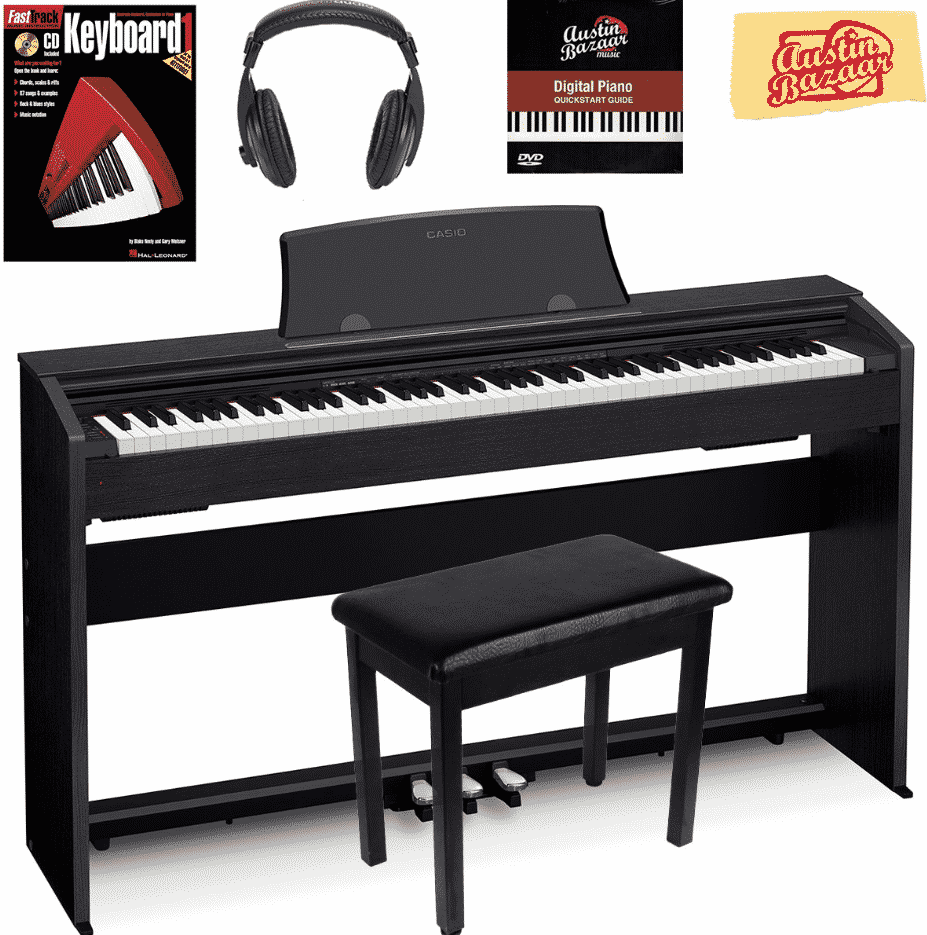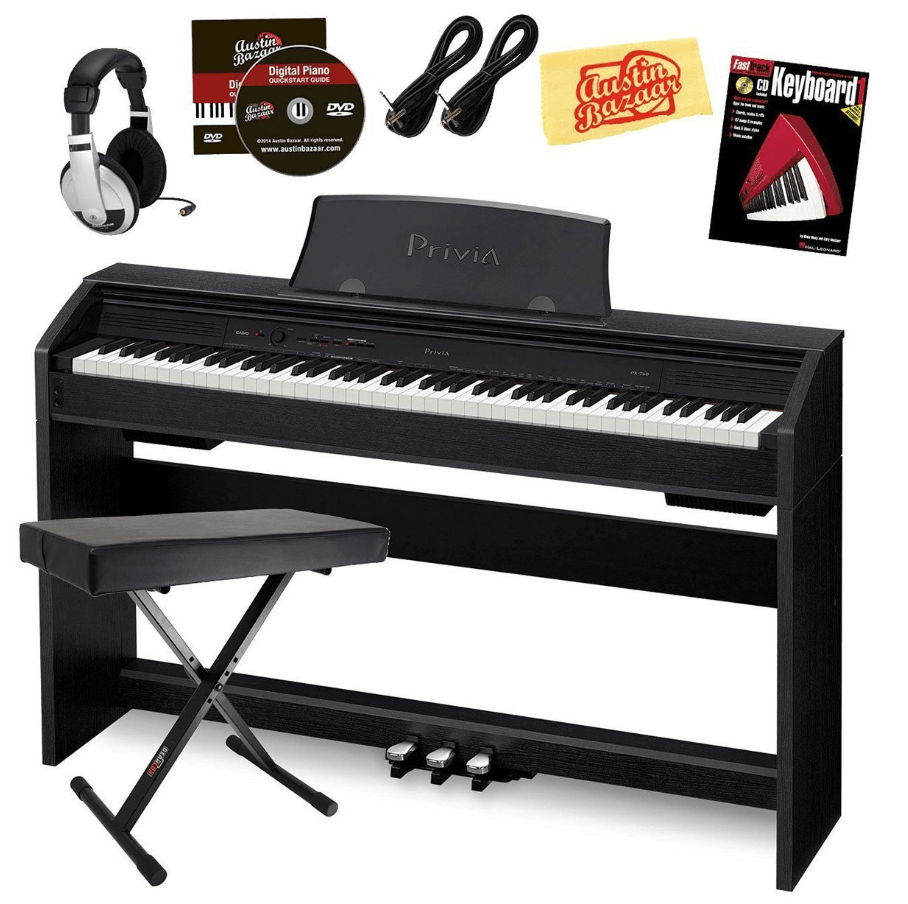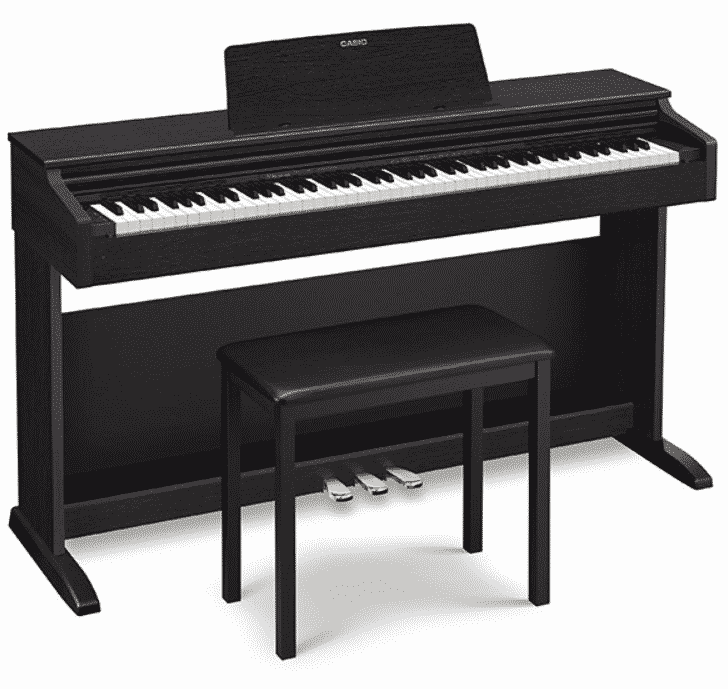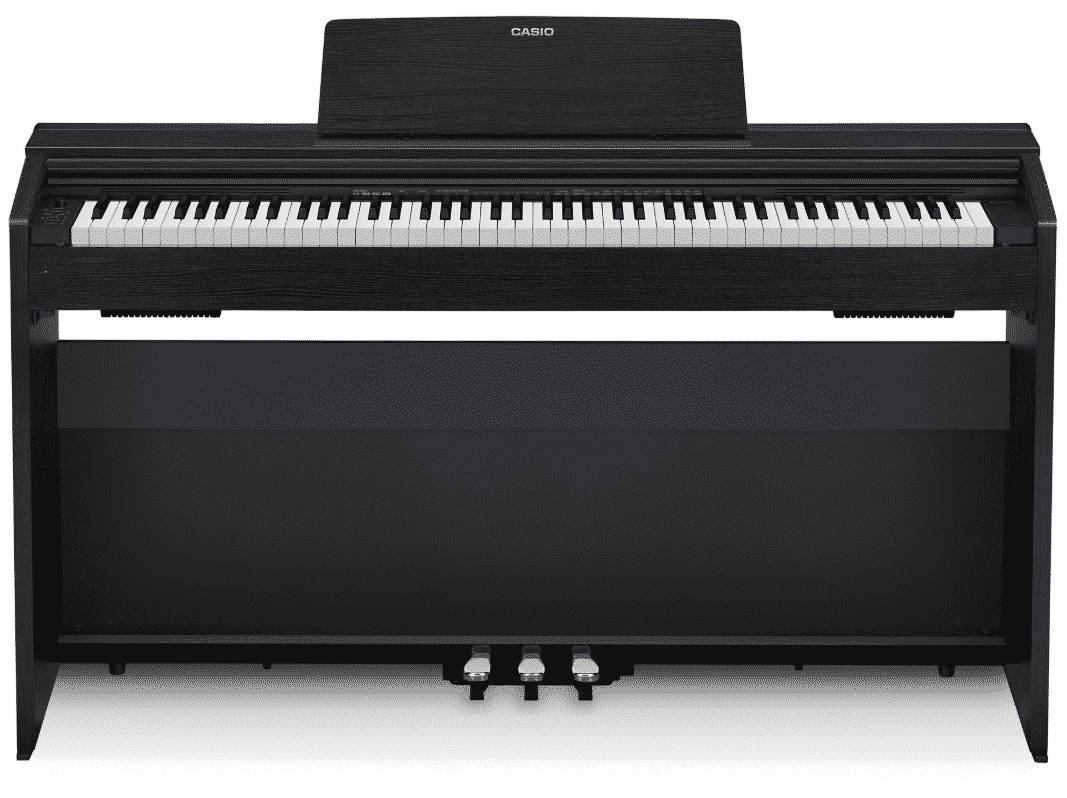The Casio PX 770, which provides the sound and feel like a true grand piano, is a digital piano that has slim and modern construction.
A sliding keyboard cover and a stand like a real piano make the cabinet look furniture-style and classic. Plus, the price is reasonable (under $700).
Why don’t you invest one?
The whole information related to the PX770, including the outstanding features, pros, cons, and some comparisons is just below.
Reading our Casio PX 770 review before purchasing is necessary. Let’s see!
Specs Of Casio PX 770
- Keyboard: 88-key scaled, weighted hammer-action keyboard with simulated ivory and ebony feeling
- Touch Sensitivity: 3 types, off
- Sound: Multi-dimensional Morphing AiR Sound
- Polyphony: 128 notes
- Effects: 11, including 3 x brilliance, 4 x reverb, 4 x chorus
- Internal Songs: 60
- Recording: 2-track MIDI recorder
- Audio Outputs: 2 x ¼ inches
- Modes: Dual, Duo (Duet Play), Split (Low-range bass tone only)
- Pedals: 3-pedal – soft, sostenuto, damper
- Speakers: 8W + 8W
- Power Source: Include 12V AC power
- Item Dimensions: 11.77 x 54.53 x 31.42 inches
- Weight: 69.5 pounds
- Model Number: PX-770
Casio PX 770 Review
The Casio PX 770 is preferred today. Why? If the Casio PX 770 only has an attractive look, the consumers will quickly forget its existence.

Keyboard
The PX770 has a fully weighted keyboard with simulated ivory and ebony keytops that you can only find on the Casio digital pianos under $2000.
It is worth noting that:
The weighted keys of the PX770 are even real hammers.
Not only do you feel as playing on an acoustic piano but they also offer mechanical movement.
Thanks to simulating the acoustic piano’s features that scaled hammer system bring, the heavier the keys, the lower the registers will be.
They only become lighter in case you go up the keyboard.
The PX770 also utilizes a tri-sensor detection system in each key.
It allows repeating note faster. In addition to the touch-sensitive keys, the change of the volume is based on the soft or hard when you play.
There are 3 different settings to adjust the touch sensitivity level. To produce a similar volume whether you strike hard the keys, you likely turn off the touch sensitivity.
Sound
The Multi-dimensional Morphing AiR Sound Source is the Casio’s proprietary. So, the PX770 also has equipped this sound source.
With the AiR processor, the memory capacity is large. The quality of the samplers and the sound is better and more accurate.
To compress the sound data, the Casio utilizes lossless audio technology. It helps the original piano sound reproduced without reducing the quality.
The next is the upgraded grand piano sound in the PX770.
Using the stereo samples in a grand piano, you can record at four dynamic levels.
Players also feel the seamless variations in volume and tone, either the powerful fortissimo or the soft pianissimo.
It optimizes the sound, so the PX770 added a new sound.
There are 19 unique sounds so that you might play: bass, two strings, four electric pianos, harpsichord, four organs, five grand pianos, and vibraphone.
Unlike Casio’s later versions, the PX770 does not feature a Hall Simulator function. Instead of, it has chorus and reverb effects to adjust the sound as expected.
- Reverb: There are different types to use, including a Large Hall, Stadium, Room, and Small Hall.
- Chorus: The sound becomes richer and fuller with 4 types of the chorus effect.
Polyphony
Having 128 notes of polyphony, this number is ideal enough for any seasoned musician.
Frequently, you can only find digital pianos within 128 – 192 notes of polyphony in the price range.
For every song, you cannot record over two tracks in the PX770. That’s why you hardly ever have to need plenty of polyphony.
Speakers

The Casio has built up two speakers, along with amplifiers.
The sound of these speakers is loud enough for you to perform in a small space or play casually.
Of course, we cannot compare the 16W sound system to a real piano, but that sound system set up in the PX770 is very decent.
The sound quality is great at any volume.
We also admit that the cabinet design contributes to bringing the optimization of the speaker system. The sound is both bigger and more resonant.
Connectivity
Equipping a fundamental set of connections, the PX770 enables users to utilize the piano with an array of external devices.
There are two ¼-inch stereo jacks on the front. The purpose is to connect two headphones simultaneously.
You can even use these jacks to connect the piano to the PA system, external amplifier, etc. for sound reinforcement.
You do not hurry disappointed when the PX770 does not equip the dedicated line out jack.
There is also the USB port so that you can exchange the files and MIDI data from the piano to your computer.
Remember that you likely utilize this instrument as a MIDI controller when connecting the PX770 to the computer. Your computer will receive that MIDI data.
Unfortunately, this instrument does not attach the USB cable, so you will have to purchase it separately.
Other Features
Modes
You can utilize some of the sounds while performing. You can even turn on the four-hand mode for two-people piano playing at once.
These are due to 2 versatile modes setup inside the PX770.
With the dual mode, layering and playing two different sounds to create a more atmosphere and complex sound are simple.
If an acoustic piano is layered with a string, it will be a nice combination.
You may layer any of 19 sounds, not including the bass sound.
Adjusting the volume of tones (making this tone more dominant than another) will need the support of the layer balance.
The Split Mode built-in the PX770 also allows you to play with two various sounds, by splitting the keyboard.
In this way, you easily assign a different sound, the left-hand section for the bass sound and the right-hand for any sound you like.
For the teachers, they enjoy Duet Play. The keyboard will be split into two equal parts so that the teachers and their student play similar notes simultaneously.
Concert Play And Built-In Songs
The Casio does not construct accompaniment function in the PX770, but they have designed another great feature, Concert Play. You can play with the recordings of a live orchestra.
With 10 tunes, each consists of 2 parts – orchestra part and piano part.
Initially, you listen to a familiar tune yourself with what you play. Next, each hand can practice the piano part of Concern Play.
The last one is to play the piano part with the turned-on orchestra accompaniment.
Personally, we love these recordings, which are like real orchestra recordings.
We have expected more than, but the PX770 only has 10 of them.
The Casio adds 60 various built-in piano songs to the PX770.
And you can utilize these songs in a similar way to Concert Play songs.
It means that you may change the tempo, listen to them, or practice hands separately.
Recording And Playback
When talking about recording, we especially like the PX770’s 2-track MIDI recording. Generally, you will be able to record two tracks for each song and then play them back together.
With a different instrument part, you may record it to each track to create complicated multi-instrument songs.
While playing back another track, you should turn off one of the tracks and play live. If desired, you can practice the L and R part separately.
How unfortunate! You will not likely record the instrument sound because the PX770 does not have an audio recorder.
What We Like
- The weight keys feel like an acoustic piano
- Some good characteristics: 19 unique sounds, 2-track MIDI recorder, Concert Play feature
- The keyboard has accurate sound quality
- Look great
- It has a unique piano sound
- Compact
- Affordable
- The pedals are great
What We Don’t Like
- The USB port is small
- Not including audio record
- The quality of the stand is not amazing
Comparisons
The comparisons will help you know about the PX770 better.
Yamaha P115 Vs. Casio PX 770
The P115 is a portable piano, but you can equip a stand and 3-pedal bar to get the same look and price as the PX770.
Owning common intermediate keyboard from Yamaha, the P115 provides the Pure CF sound engine, 192-note polyphony, and Standard Graded Hammer Action.

Yamaha P115
Aside from a high-quality piano sound sampled from Concert Grand of the Yamaha CFIIIS 9, the P115 includes the 14W speaker system.
But, if compared to the 16W onboard speakers built-in with the cabinet design sound that the PX770 provides, the P115’s seems worse.
We also recognize other different features of both:
The PX770 has hammer response feature and 5 exclusive instrument sounds while the Yamaha adds 10 accompaniment styles, dedicated Line Outs, and full Split Mode.
From my point of view, the P115 is especially portable, so you easily carry it to practice and play anywhere.
Whereas the PX770 properly places at home and you cannot use it unless you use a stand.
Casio PX770 Vs. Casio PX760

The PX770 is later than the PX760. The PX770 has the quite small size, but the Casio upgrades optimal features inside.
- Chip on board contributes to improving the sound of the PX770. It makes melody more natural.
- The manufacturer upgraded voices up to 19 ones, plus an acoustic piano sound.
- The PX770 looks more appealing with the raised cabinet, in particular, nicer built-in speakers and fewer seams.
The PX770 also offers another optimum feature – the price-tag.
The cost cannot beat the number of accompaniments, features, and voices.
Therefore, you can consider PX-770 as the best beginner digital piano that won’t break the bank.
Yamaha P125 Vs. Casio PX 770

Both the Casio and Yamaha designs their piano with 88 keys.
The P125 provides the Graded Hammer Standard 88-key piano keyboard and the PX770 has constructed Tri-sensor Scaled Hammer Action keyboard.
The 2-speaker system makes the sound of both loud and clear.
The P125 uses the pure CF sound engine to reproduce the tone. Whereas the PX770 features New AiR Sound Source to produce the melodies.
What features are the P125 similar to the PX770?
There are the portable construction and Split mode to play a various voice with each hand.
Instead of the audio features, the P125 provides tempo range within 5 – 280.
As previously stated, when talking about the sound, you are difficult to find a piano that can beat. 18 tones, 128-note polyphony, and an array of songs in the music library occupied completely.
Casio PX 770 Vs. Casio AP 270

The different product line leads to many different features whether the PX770 and AP270 have the same brand.
The cabinet: The AP270 is not as open as the PX770.
Songs and recording: With 60 built-in songs and 10 recordings, the PX770 is actually better-appointed.
That’s why the PX770 suits at home, in a lesson studio, and others.
Tones: The AP270 is more dominant. The AP270 offers 22 tones, which is more than the PX770 3 tones.
Even, the PX770 is also worse than the AP270 for the number of polyphony notes.
Except for these differences, the rest of both is the same.
We have to say that: “Tweedledum and Tweedledee”.
Casio PX 770 Vs. PX 870

What to compare between the Casio PX 770 and PX870?
| PX 770 | PX 870 |
|---|---|
| |
| 128-note polyphony | 256-note polyphony |
| 2-speaker | 4-speaker |
| Opener cabinet | The back is much closer |
| The source of the sound involves action noise and damper | |
The PX870 is stronger, more expensive, and richer in the sound if compared to the PX770.
This is easy to understand because the PX770 is the older version.
What piano do you want to play?
I would suggest you to check our Casio PX 130 review as well. The PX 130 is a great choice if you are a beginner.
Conclusion
Are you looking for a piano built-up basic functions? Or simply, you are a piano learner, who want to play great songs.
We recommend the Casio PX 770.
It has a great keyboard that allows creating a great feel. It is noticeable the luxurious look. The construction is built-up with the durable wood, but it does not take up more space.
We claim that you are not disappointed when choosing to invest this instrument, except for you search for more features.
Our Casio PX 770 review showed these clearly. Do you agree?